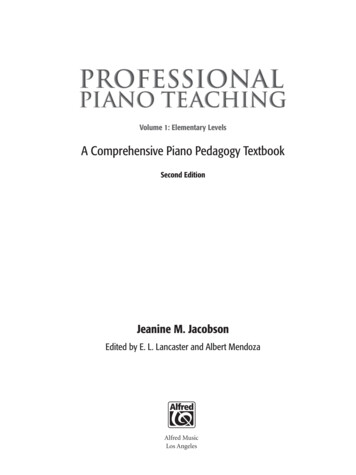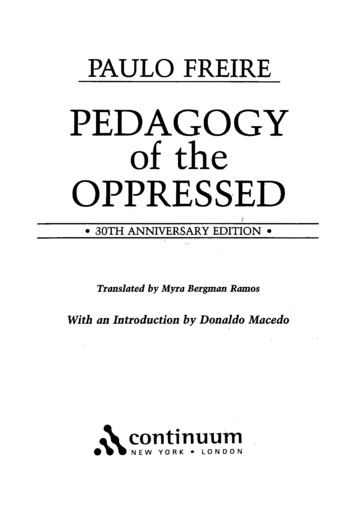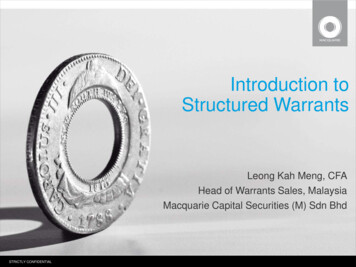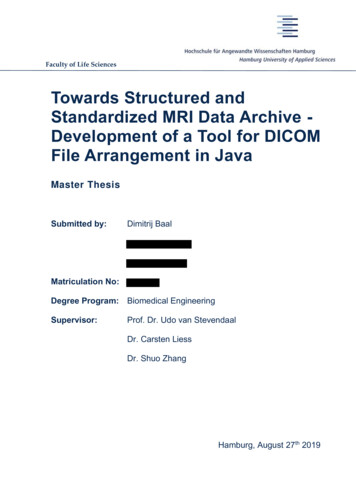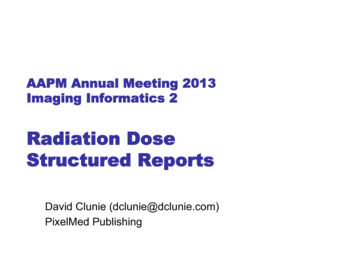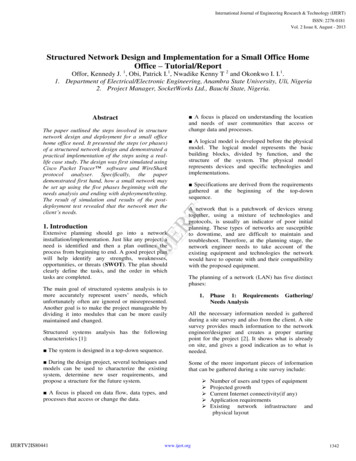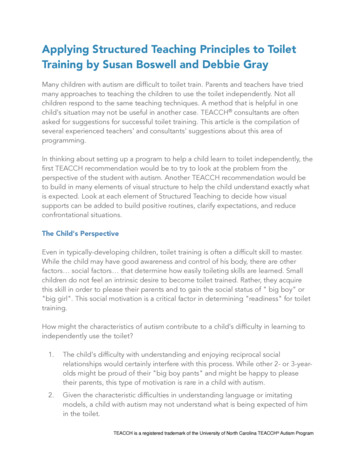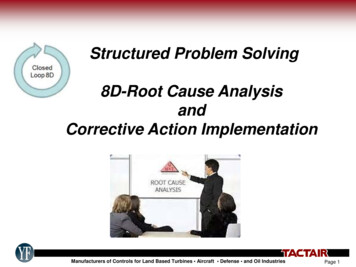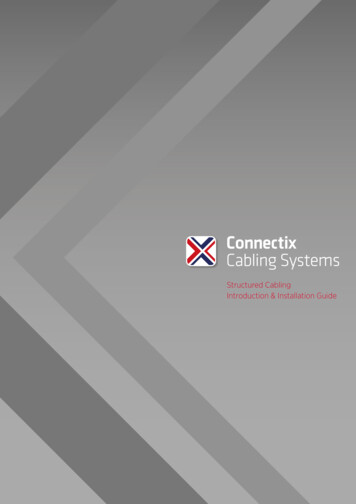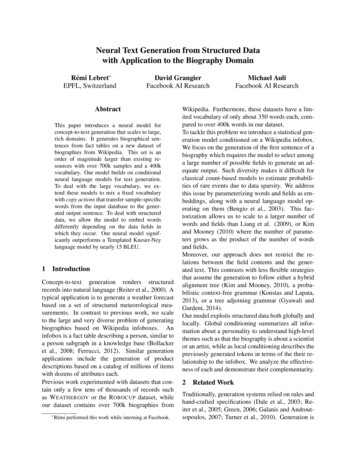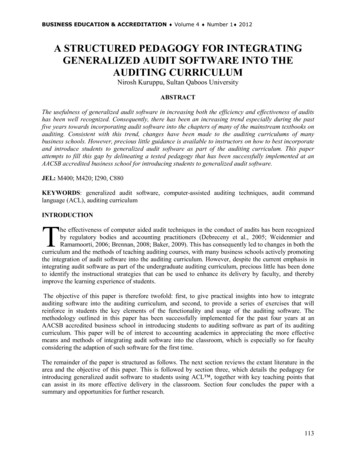
Transcription
BUSINESS EDUCATION & ACCREDITATION Volume 4 Number 1 2012A STRUCTURED PEDAGOGY FOR INTEGRATINGGENERALIZED AUDIT SOFTWARE INTO THEAUDITING CURRICULUMNirosh Kuruppu, Sultan Qaboos UniversityABSTRACTThe usefulness of generalized audit software in increasing both the efficiency and effectiveness of auditshas been well recognized. Consequently, there has been an increasing trend especially during the pastfive years towards incorporating audit software into the chapters of many of the mainstream textbooks onauditing. Consistent with this trend, changes have been made to the auditing curriculums of manybusiness schools. However, precious little guidance is available to instructors on how to best incorporateand introduce students to generalized audit software as part of the auditing curriculum. This paperattempts to fill this gap by delineating a tested pedagogy that has been successfully implemented at anAACSB accredited business school for introducing students to generalized audit software.JEL: M400; M420; I290, C880KEYWORDS: generalized audit software, computer-assisted auditing techniques, audit commandlanguage (ACL), auditing curriculumINTRODUCTIONThe effectiveness of computer aided audit techniques in the conduct of audits has been recognizedby regulatory bodies and accounting practitioners (Debreceny et al., 2005; Weidenmier andRamamoorti, 2006; Brennan, 2008; Baker, 2009). This has consequently led to changes in both thecurriculum and the methods of teaching auditing courses, with many business schools actively promotingthe integration of audit software into the auditing curriculum. However, despite the current emphasis inintegrating audit software as part of the undergraduate auditing curriculum, precious little has been doneto identify the instructional strategies that can be used to enhance its delivery by faculty, and therebyimprove the learning experience of students.The objective of this paper is therefore twofold: first, to give practical insights into how to integrateauditing software into the auditing curriculum, and second, to provide a series of exercises that willreinforce in students the key elements of the functionality and usage of the auditing software. Themethodology outlined in this paper has been successfully implemented for the past four years at anAACSB accredited business school in introducing students to auditing software as part of its auditingcurriculum. This paper will be of interest to accounting academics in appreciating the more effectivemeans and methods of integrating audit software into the classroom, which is especially so for facultyconsidering the adaption of such software for the first time.The remainder of the paper is structured as follows. The next section reviews the extant literature in thearea and the objective of this paper. This is followed by section three, which details the pedagogy forintroducing generalized audit software to students using ACL , together with key teaching points thatcan assist in its more effective delivery in the classroom. Section four concludes the paper with asummary and opportunities for further research.113
N. Kuruppu BEA Vol. 4 No. 1 2012BACKGROUND AND LITERATURE REVIEWWith the increased prevalence and reliance on information technology by organizations, there has beenconsiderable interest in information technologies that can assist auditors in conducting more efficient andeffective audits. In the current tough economic climate with audit firms facing considerable pressure to beas efficient as possible, technology based audit techniques are seen as an effective way to expedite andmaximise audit efforts significantly (Baker, 2009; IIARF, 2009). The technologies available to the auditorrange from continuous audit management programs such as Approva and AutoAudit to othercomputer assisted auditing techniques in the form of generalized audit software such as ACL andIDEA (Brennan, 2008; Baker, 2009; IIARF, 2009).It is therefore imperative that auditors become familiar with current developments in IT based audit toolsto fully harness their potential as a means towards increasing audit efficiency. However, there is currentlya considerable shortage of well-trained accounting graduates with the requisite IT knowledge (O’Donnelland Moore, 2005). This has led some large accounting firms to cross-train current staff in informationtechnology, and has encouraged audit firms to provide relevant IT related training to their staff(Debreceny et al., 2005; O’Donnell and Moore, 2005; Weidenmier and Ramamoorti, 2006; Baker, 2009).Audit firms are now, as a result, increasingly providing training on the use of computer assisted auditingtechniques (CAATs) to their employees. CAATs can improve the productivity and efficiency of audits,and generalized audit software are one of the most commonly used forms of CAATs (Debreceby et al.,2005; Weidenmier and Ramamoorti, 2006; Baker, 2009). These techniques can reduce the time taken tocomplete the audit, and therefore, the cost of the audit (Brennan, 2008; IIARF, 2009). Furthermore, itenables the auditor to increase audit coverage by performing a more comprehensive audit, such as whenthe entire population can be tested effortlessly without having to resort to sampling (Lanza, 1998; Baker,2009; IIARF, 2009).Given the value and usefulness of information technologies in the form of CAATs in conducting moreefficient and effective audits, there is an increasing demand for accounting graduates who are familiarwith CAATs (Weidenmier and Herron, 2004; and Sharifi, 2004; O’Donnell and Moore, 2005). It istherefore essential that efforts are taken to integrate CAATs into the auditing curriculum, and businessschools have been asked to help in this effort by producing accounting graduates who are capable ofmeeting the demands of employers (Weidenmier and Herron, 2004; and Sharifi, 2004; O’Donnell andMoore, 2005). To achieve the latter objective, computer-based learning, which is a subset of e-learning isespecially appropriate due to the significance of the information technology content inherent in CAATs.E-learning strategies includes instruction delivered via a computer either led by an instructor or even selfpaced learning (Bates and Poole, 2003; OECD, 2005; Clark and Mayer, 2007). This view is furthersupported by Bates (2009) who asserts that a major argument for e-learning pedagogies is that it enablesthe development of essential skills and competencies required by a profession or discipline byincorporating information technologies within the curriculum.Consequently, a number of mainstream auditing textbooks over the past five years have responded toaccounting firms’ need for graduates with specific IT skills by integrating generalized audit software intothe content of their texts through the use of computer based learning. These include the popular auditingtextbooks by Arens, Messier, Rittenburg and Louwers. Integrating auditing software into the respectivetexts in this manner is expected to improve students’ learning experience by exposing them to computerbased methods used by auditors in the modern audit environment, which is a critical skill. It is alsoexpected to make students’ with skills in CAATs more marketable to potential employers (O’Donnell andMoore, 2005; Baker, 2009).Although the necessity of developing specific training programs in IT for auditors is recognised by priorresearch, only a very limited number of studies have looked into the effective pedagogies for introducing114
BUSINESS EDUCATION & ACCREDITATION Volume 4 Number 1 2012audit software as part of the auditing curriculum, as employers have requested (O’Donnell and Moore,2005; IIARF, 2009). Prior research in this area is mainly prescriptive in that they suggest a number ofexercises that can be used to introduce auditing software to students, without much emphasis on thespecific practical aspects that will enhance its delivery in the classroom. One of the early efforts in thisarea is by Gelinas et al., (2001) who presented a case study based series of assignments. Although theassignments are useful, the practical aspects of pedagogy that instructors should be aware of whenintroducing auditing software in the classroom is largely overlooked by this study.Nieschwietz et al., (2002) followed the work of Gelinas et al., (2001) and presented a series ofassignments covering the revenue cycle, conversion cycle and sampling. Their work focused on whatstudents were supposed to do in each of the presented assignments without emphasis on the pedagogicalaspects.Subsequently, Weidnmier and Herron (2004) compared the two most commonly used auditing packageson the market, which are ACL and IDEA, and provided feedback from both students and instructors onthe use of the software. By analyzing the content of the software manuals of ACL and IDEA, theysuggested how they can be used in the classroom environment. As with Gelinas et al., (2001) andNieschwietz et al., (2002), little comment was made on the pedagogical aspects of introducing thesoftware. Furthermore, no specific exercises or assignments were suggested that can enhance theintegration and delivery of the audit software as part of the auditing curriculum.The limited research in this area has also not explored the most appropriate methods of assessingstudents’ learning outcomes once CAATs are incorporated into the curriculum. In this instance, theAACSB’s Standards can be a useful foundation for exploring students’ learning outcomes and possibleassessment tools (Shaftel and Shaftel, 2007). The AACSB shows a strong preference for direct measuresof learning compared to indirect measures. Direct measures require demonstration of students’ knowledgeor skills acquired in their course of learning (Kelley et al., 2010), which would be most suitable forassessing learning outcomes for CAATs in the auditing curriculum. Examples of direct measures fromthis context might include the use of written assignments and tests incorporating the appropriate use ofauditing software.As shown by the above review of literature, integrating audit software into the auditing curriculum is anew development in many business schools. Given the limitations presented in these initial priorresearches, the remainder of this paper outlines a tested but flexible pedagogy that can be utilized tointroduce generalized audit software as part of the auditing curriculum. It first gives an overview of theauditing curriculum, technology used and resources at the AACSB accredited business school at UAEUniversity, where the pedagogy presented in this paper has been developed and implemented.PEDAGOGICAL METHODOLOGYThe auditing baccalaureate in Accounting at UAE University has three streams: Financial Accounting,Management Accounting and a General Specialization. The curriculum closely resembles the U.S. systemsince the college is AACSB accredited. For each of the three aforementioned streams, Principles ofAuditing is a compulsory course, while Advanced Auditing is an elective. Principles of Auditing is aprerequisite for Advanced Auditing. At the present point in time, many of the students who completePrinciples of Auditing also go on to take Advanced Auditing. The typical number of students in eachcourse per semester range from forty to sixty students. Each student and faculty in the university hasaccess to a laptop, with lecture halls and classrooms having Wi-Fi access.Computerized audit techniques in the form of generalized audit software is the first topic covered inAdvanced Auditing. The course profile given to students on the first day of class has three weeks115
N. Kuruppu BEA Vol. 4 No. 1 2012allocated to this topic, which comprise about twenty percent of the course. Each class session is 75minutes in duration and meets twice a week. Students in the pre-requisite Principles of Auditing class donot have any direct exposure to generalized audit software, other than being aware that these methods arenow used by auditors in gathering evidence, with appropriate examples.The textbook adapted for both Principles of Auditing and Advanced Auditing is “Auditing and AssuranceServices: A Systematic Approach” by Messier et al., (2008). The textbook is in its 6th edition and it isbundled with an educational version of the ACL 9.0 audit software. Each chapter of the book has variousACL exercises. However, it is best for the instructor to tailor the exercises to suit his or her own classdepending on how comprehensively the ACL program is integrated into the auditing curriculum.The following sections detail an effective pedagogy that can be used to introduce students to ACL in sixlecture sessions of 75 minutes each. The outlined pedagogy is flexible enough for individual instructors tomake changes to it to suit their own curriculum and class format.Class Session 1 (75 minutes)In the first class, students are given a brief lecture on ACL and its specific uses, and told how the nextthree weeks will be proceeding. Then they are asked to install the ACL software off a CD on theirlaptops. As most students do not bring textbooks to class which contains the ACL program CD until thesecond week of lectures, it is efficient for the instructor to use several copies of the CD to ensure thequick installation on each of the students’ laptops. Students are specifically asked to also install the ‘ACLin Practice’ PDF file as part of the installation routine.Class Session 2 (75 minutes)The second class starts the hands on practice using ACL. Prior research such as Weidnemier and Herron(2004) show that they essentially got students to go through the ACL workbook at their own spacecovering the first five modules. However, having first tried this approach, it was found to be morechallenging for students as they had to familiarize themselves with the program and it capabilities on theirown, with minimal input from the instructor.A more effective method that improve the cognitive experience of students and get them off to a quickstart is to first familiarize them with the ACL workspace, and then go on to the necessity of creating anACL project, which precursor any analysis. This is done using a separate dataset on a company’s accountsreceivable data (available from the author on request). During this time, key points including the need todefine data columns in the proper formats are explained. This first visual introduction to ACL is easilyachieved by the use of a projector hooked onto the instructor’s laptop. It is also important to informstudents that the source data used in creating the project is secure, as ACL does not modify them at all.Most students initially fail to see the purpose of creating a project in ACL, as they are mainly familiarwith spreadsheets such as Excel. It helps at this juncture to stress that an ACL project is like a drawer or acabinet, which is used to store all the relevant data for a particular audit. Once the project has beencreated, the concept of data categories should be explained in more detail, emphasizing that the threecommonly encountered data types in ACL is character (ascii), numeric and date formats (Arens andElder, 2008). Many students will have the misconception that if a particular column in ACL containsnumbers, then it should be defined as numeric data. It is helpful to tell students that if a particular columnis not going to be used for performing mathematical operations, then it should be set as character, unless itcontains date type data. The example of a column of students’ ID numbers can be used to illustrate thisfurther. Since there is little value in adding or subtracting students’ ID numbers, such a column should bedefined as character even though they comprise of numbers or digits. This can be contrasted with acolumn of sales figures, where the auditor would be interested in obtaining the total value of sales or thehighest value of a sales transaction. Such a column should always be defined as numeric.116
BUSINESS EDUCATION & ACCREDITATION Volume 4 Number 1 2012After this visual introduction to ACL, students are asked to work through the first two chapters of the‘ACL in Practice’ manual in the remainder of the class. This can be achieved by students in about 45minutes as the first chapter is only a description of the fictitious company used in the manual. Chaptertwo requires students to open an existing project and familiarize themselves with basic ACL functionssuch as the statistics command and duplicate commands. It also introduces students to simple filters.Class Sessions 3-5 (225 minutes)Once the students are familiar with the basics, they proceed to complete chapters 3-5 chapters in the‘ACL in Practice’ manual during the next three subsequent class sessions. These three chapters requirestudents to first create a new project from a number of file types including Excel, Access and Text files.More advanced aspects of ACL are covered in these sessions, comprising of advanced filters andfunctions. Each chapter is allocated one class session of 75 minutes, and most students are able tocomplete each of the chapters in less than 75 minutes. During these sessions the instructor will monitorthe progress and provide feedback. It was also found to be practical and effective at this stage to engage2-3 students who are ahead of the other students to help their colleagues in going through the morechallenging parts of the chapters. It was found that the chosen students were eager to contribute in thisway, and it also ensured that students needing assistance received it in time as the instructor may not havesufficient time to devote to each individual student, especially in large classes.By the end of chapter five, most students will have a good grasp of the key ACL commands ranging fromthe creation of projects to the writing of appropriate filters to achieve specific objectives such as to isolateinvoices amounts within a given range. A number of students, however, will still overlook the importanceof having to properly define variable columns according to the data types. It is therefore important for theinstructor to frequently remind students of this critical task before starting to perform any analysis usingACL.Class Session 6 (75 minutes)Session six is the final session and it is used to reinforce in students the main concepts that they havelearned in the previous classes. Each student is provided with a printed sheet of six ACL exercises whichthey are required solve within 45 minutes, utilizing an accounts receivables dataset. The data in Excelformat is made available to students via Blackboard , and is also available to the reader on request. Theaccounts receivable file has nine variables which are summarized in Table 1 below.Table 1: Accounts Receivable Data DefinitionsVariable NameAmountAR ClerkAuthorizedCash Receipts ClerkCredit LimitCustomer NumberDue DateGL AccountingInvoice DateInvoice NumberDescriptionDollar value of the sales transactionsAccounts receivable clerkWhether the transaction is authorized or not. Transactions exceeding the credit limitneed authorizationCash receipts clerkCredit limit of the customerCustomer’s unique numberDue date of the invoiceGeneral ledger clerkInvoice dateInvoice numberData cterDateCharacterDateCharacterThe data used in the exercises is available from the author on request.117
N. Kuruppu BEA Vol. 4 No. 1 2012Students are instructed to first create a project and import the Excel data into ACL format beforeattempting the exercises. Most students are able to achieve this in a couple of minutes. At this juncture, itis also useful to reiterate the importance of defining the data appropriately as either character, numeric ordate type before conducting any analysis. Once this is done, the ‘verify’ command can be used toascertain whether the data matches the assigned data type. After these preliminary remarks, the s
KEYWORDS: generalized audit software-assisted auditing techniques, audit command , computer language (ACL), auditing curriculum . INTRODUCTION . he effectiveness of computer aided audit techniques in the conduct of audits has been recognized by regulatory bodies and account
